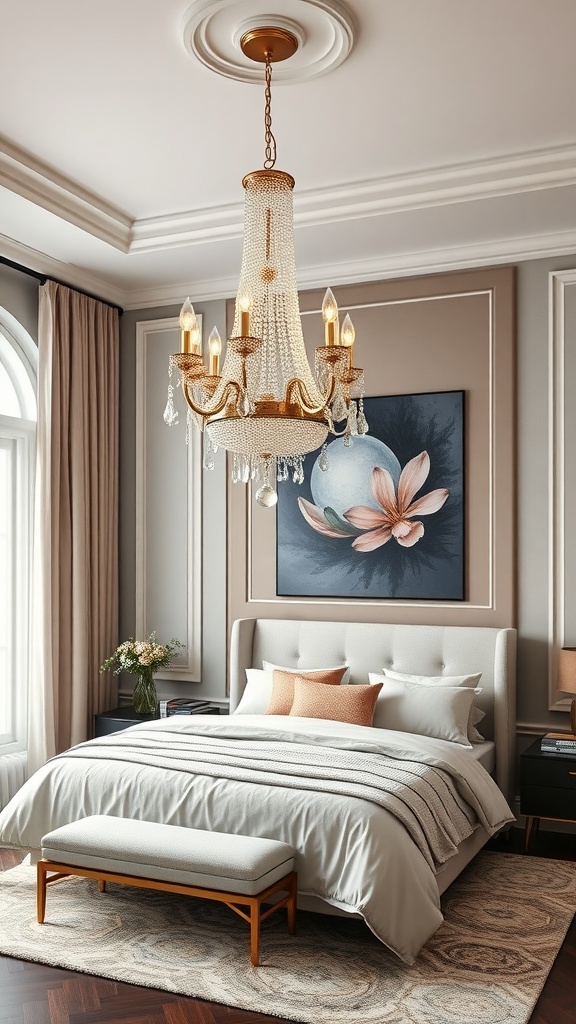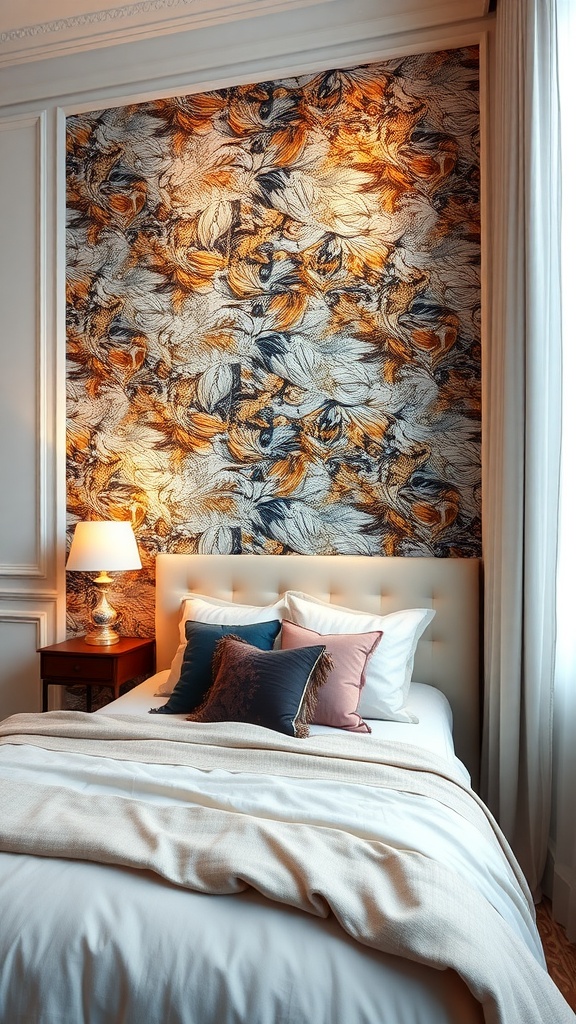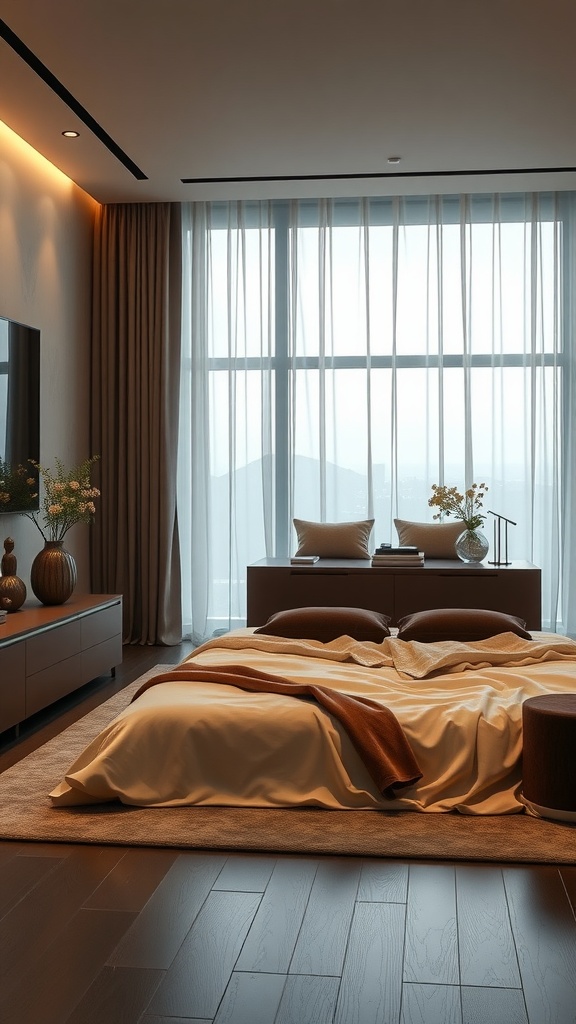Creating a modern luxury bedroom is about blending comfort with style, giving you a space that feels both cozy and chic. Think sleek lines, sumptuous fabrics, and unique decor that reflects your personality. A well-designed luxury bedroom invites relaxation and rejuvenation, making it the perfect retreat at the end of the day.
Sophisticated Color Palettes

In a modern luxury bedroom, color palettes play a significant role in creating a serene space. The deep blue hues on the walls provide a calming backdrop, inviting relaxation and comfort. This color choice is not just stylish; it also sets a cohesive tone for the entire room.
The interplay of dark tones with soft textiles adds depth. For instance, the bedding and throw pillows in varying shades of blue complement the walls beautifully. This layering effect enhances the overall sophistication of the modern luxury bedroom.
Accents in gold add a touch of warmth and elegance. The gold fixtures and decorative elements create a striking contrast against the blue, making the space feel more inviting. This mix of colors and textures brings a refined look to the modern luxury bedroom.
Natural elements, like the small plant on the side table, introduce a lively touch. Greenery not only brightens the space but also adds a fresh vibe that balances the deeper colors. This thoughtful combination enhances the atmosphere of the modern luxury bedroom.
The use of a plush area rug under the furniture ties everything together. It softens the space and adds comfort underfoot. Choosing a light color for the rug contrasts with the dark floor, further emphasizing the elegant style of the modern luxury bedroom.
Stylish Nightstands

In a modern luxury bedroom, the nightstands play a key role in enhancing the overall look. These nightstands are not just functional; they add style and elegance. With their unique design, they effortlessly complement the sophisticated vibe of the room.
The combination of warm wood tones and soft cream shades creates a pleasing contrast. Each nightstand features three spacious drawers, perfect for storing bedtime essentials. The details on the drawers, including golden handles, reflect a commitment to quality and aesthetics.
Lighting is crucial in a modern luxury bedroom. The stylish lamp on the left nightstand provides a warm glow, making it ideal for late-night reading. This thoughtful addition emphasizes the practicality of these nightstands while also contributing to the cozy atmosphere.
Floral arrangements on one side add a touch of freshness and life to the setting. This small detail makes the space feel inviting and personal. In a modern luxury bedroom, these nightstands not only serve as functional storage but also enhance the decorative aspect of the room.
Overall, choosing stylish nightstands is essential in creating a modern luxury bedroom. They should be both beautiful and practical, ensuring that your space remains organized and visually appealing. Every element, from the materials to the colors, works together to define the luxury and comfort associated with this design style.
Indulgent Bedding Choices

When you think about a modern luxury bedroom, the right bedding can make all the difference. Picture a bed with crisp white sheets that invite you in for a restful night’s sleep. The soft, smooth texture of these sheets is not only comfortable but also adds a touch of elegance.
The pillows are plush and inviting, perfectly complementing the bedding. They promise support and comfort, making it easy to sink into relaxation. A cozy throw blanket draped across the foot of the bed adds a pop of color and warmth, making the space feel more intimate.
Every detail counts in a modern luxury bedroom. The combination of the white linens and the warm, earthy tones of the throw creates a soothing vibe. This kind of indulgence is about more than just aesthetics; it’s about creating a space where you can truly unwind.
Investing in quality bedding not only enhances your comfort but also elevates the overall look of your bedroom. It transforms a simple sleeping area into a luxurious retreat. So, when designing your modern luxury bedroom, think about how each element of bedding contributes to your comfort and style.
Statement Lighting Fixtures

In a Modern Luxury Bedroom, lighting plays a key role in setting the mood and style. A stunning chandelier hangs elegantly from the ceiling, serving as a central focus in the room. This kind of lighting fixture isn’t just practical; it’s a statement piece that draws the eye and adds a touch of glamour.
The chandelier shines brightly, its glass elements reflecting light beautifully. This creates a warm glow that enhances the cozy atmosphere of the space. The combination of soft hues and textures in the bedding complements the luxurious feel of the room, making it inviting and serene.
Statement lighting fixtures like this chandelier transform a simple bedroom into a chic retreat. They elevate the overall design, making a statement without overwhelming other elements in the space. Whether you prefer bold designs or something more understated, lighting is essential in creating a Modern Luxury Bedroom.
Incorporating such a fixture can change how you perceive the room. You may find yourself admiring the view from your bed, appreciating how the light interacts with different surfaces. A well-chosen chandelier not only illuminates but also enhances the aesthetic, making it a fundamental part of the Modern Luxury Bedroom experience.
Relaxing Reading Nooks

A relaxing reading nook is a perfect addition to any modern luxury bedroom. This cozy corner features a stylish armchair that invites you to sit back and unwind. The soft textures and cushions create a comfortable atmosphere, making it an ideal spot for enjoying a good book.
The natural light streaming through the window adds to the inviting feel of the space. Nearby, neatly arranged books on a shelf showcase a variety of genres, ready to be explored. A small side table holds a plant, enhancing the serenity of this modern luxury bedroom.
This reading nook isn’t just about functionality; it’s a space for reflection and escape. Having a dedicated area for reading encourages relaxation. The combination of warmth, light, and design creates a personal retreat, making it a highlight of the modern luxury bedroom.
Creating your own relaxing reading nook can transform your bedroom into a sanctuary. Choose a comfortable chair, add a few cozy pillows, and keep your favorite reads within arm’s reach. A soft rug and warm lighting complete the look, inviting you to settle in for hours of reading bliss.
Smart Home Integration

In a modern luxury bedroom, smart home integration makes life easier and more enjoyable. Imagine adjusting your lighting or temperature with just a tap on your smartphone or a voice command. This bedroom design features sleek lines and minimalist decor, which pairs perfectly with smart technology.
The bed’s elegant frame and cozy pillows invite relaxation. Smart lighting under the bed creates a warm glow, enhancing the overall feel of the space. You can customize the settings to match your mood, making it a versatile haven for rest.
Smart home devices also add functionality. For example, you can program your blackout curtains to open at sunrise, letting in natural light without any effort. This feature supports a better sleep routine, aligning with the luxurious vibe of the room.
Incorporating technology, like a smart speaker, allows you to play soothing music or white noise for a peaceful night’s sleep. The modern luxury bedroom concept revolves around comfort, convenience, and style, showcasing how technology can enrich our daily lives.
Overall, a modern luxury bedroom equipped with smart home integration offers a seamless blend of comfort and functionality. It’s the perfect setup for anyone looking to elevate their living experience.
Elegant Textures and Fabrics

In a modern luxury bedroom, textures and fabrics play a significant role in creating a cozy yet sophisticated space. The image showcases soft, layered bedding that invites relaxation. The plush duvet and pillows add comfort and style, making this area a perfect retreat.
Curtains in warm tones elegantly frame the window, adding depth to the room. The fabric drapes beautifully, enhancing the overall look. These textiles are not just for decoration; they also contribute to the room’s comfort, helping to control light and sound, perfect for a restful sleep experience.
Every element in this modern luxury bedroom is chosen with care. The bedside lamp, with its intricate design, adds a touch of glamour. This blend of textures and fabrics, combined with thoughtful placement, creates a harmonious and inviting atmosphere.
In summary, the elegant textures and fabrics elevate the modern luxury bedroom experience. They invite you to unwind and escape the daily hustle. A well-designed bedroom not only looks good but feels good, making it an essential part of any home.
Chic Accent Walls

In a modern luxury bedroom, chic accent walls play a significant role in defining the overall style. This image captures a beautiful accent wall adorned with a striking, colorful pattern. The intricate design adds depth and personality to the space.
Accent walls can completely change the vibe of a room. The bold colors and lively patterns in this design create a focal point that draws the eye. It’s a perfect example of how an accent wall can enhance a modern luxury bedroom.
The choice of colors, like warm oranges and cool blues, harmonizes well, offering a stylish contrast. This dynamic blend not only energizes the bedroom but also complements the softer tones of the bedding, creating a cohesive look.
Lighting is another key element here. The warm glow from the lamp accentuates the wall, highlighting its beautiful details. This thoughtful lighting choice makes the wall even more inviting, showcasing its charm in a modern luxury bedroom.
Adding decorative pillows in various textures and colors on the bed ties the whole room together. This approach creates an inviting and luxurious feel. Overall, this chic accent wall is a statement piece that elevates the entire modern luxury bedroom.
Artwork and Personal Touches

In a modern luxury bedroom, artwork plays a key role in setting the mood. The pieces selected should reflect personal taste and add character to the space. For instance, a striking landscape painting can bring the outdoors in, making the room feel serene and inviting. This contrast of nature against a chic interior creates a welcoming vibe.
Adding a portrait can create an intimate atmosphere, making the room feel lived-in and personal. The choice of frames also matters. Elegant frames can elevate a simple print, turning it into a statement piece in your modern luxury bedroom.
It’s not just the walls that need attention. Personal touches, like decorative items or books on a nightstand, can bring warmth to the space. Arrange these items thoughtfully to complement the overall design. Layering textures, such as a soft throw or plush cushions, can also enhance the luxury feel.
Consider lighting as part of your personal touch. Soft, adjustable lighting can highlight artwork and create a cozy nighttime atmosphere. Choosing the right lamps and fixtures brings functional beauty to the modern luxury bedroom.
Each piece and detail contributes to the overall style. They invite guests to appreciate your personality while enjoying a luxurious environment. The balance between art and personal touches is what truly defines a modern luxury bedroom.
Minimalist Furniture Designs

The image of this modern luxury bedroom showcases a blend of simplicity and comfort. Minimalist furniture plays a key role in creating a serene space. The bed, with soft linens and subtle colors, invites relaxation. It’s designed to be both stylish and functional, ensuring that the modern luxury bedroom remains uncluttered.
The use of a soft ottoman and a sleek side table complements the overall look. These pieces are not just for decoration; they enhance the room’s practicality without overwhelming it. Each item in this modern luxury bedroom highlights the beauty of less is more.
The large windows let in natural light, further emphasizing the room’s spacious feel. This design embraces open spaces, making it perfect for a modern luxury bedroom. The simplicity of the decor allows for personal touches, whether it be artwork or a favorite book on the table.
Overall, minimalist furniture designs in this modern luxury bedroom create a calming retreat from daily chaos. This style encourages tranquility and a sense of peace, making it an ideal choice for those seeking a serene living environment.
Rich Wood Finishes

The rich wood finishes in this modern luxury bedroom create a warm and inviting atmosphere. The deep tones of the wood add depth and character to the space. Whether it’s the flooring or the furniture, each piece enhances the overall elegance.
The wooden panels on the walls give the room a sophisticated look. They draw the eye and help define the space. The combination of the wood and soft textures creates a perfect balance.
The bed, adorned with a cozy throw, sits comfortably on a plush area rug. This setup encourages relaxation and comfort. A modern luxury bedroom should feel inviting, and this design achieves that beautifully.
Light fixtures complement the wood, casting a soft glow. The chandelier adds a touch of elegance, enhancing the room’s charm. These elements together highlight the richness of the wood finishes.
Each detail contributes to a modern luxury bedroom that reflects both style and comfort. From the rich wood to the careful arrangement, this space embodies a serene retreat.
Open Space Layouts

In a modern luxury bedroom, open space layouts create a sense of freedom and comfort. The flow of the room allows for easy movement and interaction, making it a great place to unwind. Large windows let in natural light, enhancing the overall atmosphere.
The layout focuses on simplicity and functionality. A spacious bed sits center stage, flanked by minimalistic furniture that doesn’t crowd the space. This arrangement keeps the room feeling airy and relaxed, ideal for restful nights.
The use of muted colors and textures adds a touch of warmth without overwhelming the senses. Soft fabrics on the bed and delicate accents in the decor contribute to the cozy vibe that’s so crucial in a modern luxury bedroom.
Incorporating seating areas, like stylish chairs, encourages relaxation or reading. This thoughtful design invites you to enjoy the space fully, making it your personal sanctuary.
Overall, open space layouts in modern luxury bedrooms emphasize both style and comfort. They create an inviting environment where you can truly feel at home.
Unique Ceiling Designs

In a modern luxury bedroom, the ceiling is more than just an overhead surface; it can be a statement piece. The image showcases a stunning ceiling design that combines curves and angles, creating an inviting look. This unique architectural feature adds depth and interest to the space.
The soft lighting embedded in the ceiling enhances the overall vibe, making the bedroom feel cozy and sophisticated. This design element not only draws the eye upward but also makes the room feel larger and more open.
In a modern luxury bedroom, it’s all about combining aesthetics with comfort. The careful balance of materials, textures, and colors can transform a simple bedroom into a serene retreat. A standout ceiling can set the tone for relaxation, inviting you to unwind after a long day.
Try incorporating similar ceiling designs in your own bedroom to achieve that modern luxury feel. Whether it’s a subtle curve or bold geometric shapes, the right ceiling can redefine your space. Remember, in a modern luxury bedroom, every detail counts, and a unique ceiling design can make all the difference.
Personalized Decor Elements

When thinking of a modern luxury bedroom, personalized decor elements play a huge role in making the space truly feel like home. The image showcases two decorative pillows on a stylish bed, each adorned with bold initials. This simple touch adds a unique flair that reflects personal identity and style.
Choosing personalized items, like these pillows, enhances the overall vibe of a modern luxury bedroom. It’s not just about aesthetics; it’s about comfort and warmth. Each piece tells a story, making the room inviting and intimate.
Over time, these elements can evolve. You might swap out the pillows for seasonal designs or add artwork that resonates with you. The key is to make choices that feel authentic to your character while maintaining that luxury feel.
In a modern luxury bedroom, the balance between elegance and personal touch is essential. From framed artwork to customized bedding, every detail matters. This thoughtful approach transforms a simple room into a luxurious retreat, creating a space where you truly belong.
Serene Color Schemes

In a modern luxury bedroom, the color scheme plays a huge role in creating a peaceful atmosphere. Soft, muted tones dominate the scene, bringing a sense of calm. Notice the gentle light reflecting on the wall, enhancing the serene vibe.
The use of warm whites and pastel shades can make the room feel cozy. The light brown throw and patterned rug complement the overall aesthetic. Each color choice contributes to a modern luxury bedroom that feels inviting and relaxing.
Natural elements, like the flowers, add a refreshing touch. They break up the soft tones and introduce a splash of color. This balance between the muted background and vibrant accents captures the essence of a modern luxury bedroom.
Simple furnishings keep the focus on serenity. The bed, adorned with fluffy pillows and a warm blanket, invites you to unwind. Everything in this space is curated to make relaxation effortless. A modern luxury bedroom should feel like a retreat, an escape from the busyness of life.
With a serene color palette, you can transform any bedroom into a modern luxury bedroom. It’s all about choosing colors that speak to you and setting a tone that encourages comfort and tranquility.
Sustainable Luxury Elements

The modern luxury bedroom embraces sustainability without sacrificing style. You’ll notice the use of natural materials like wood and stone, which create a warm and inviting atmosphere. These choices not only look beautiful but also have a lower environmental impact.
Soft tones and plush textures in bedding add comfort while keeping the overall design sleek. Sustainable fabrics like organic cotton and linen are perfect for a luxurious feel. The understated color palette in the image promotes a calm and serene environment, which is essential for a restful bedroom.
Lighting plays a key role too. The elegant fixture above offers a cozy glow, enhancing the natural beauty of the space. Using energy-efficient bulbs fits perfectly within the sustainable luxury theme.
Decor items made from recycled materials or local craftsmanship add a unique touch and tell a story. The circular ottoman complements the modern aesthetic while being functional and eco-friendly.
In a modern luxury bedroom, every element serves a purpose. This blend of sustainability and elegance shows that you can live beautifully while caring for the planet. It’s not just a trend; it’s a lifestyle choice.
Innovative Storage Solutions

In a modern luxury bedroom, innovative storage solutions play a key role. The image shows a well-organized space that balances style and function. You can see that the shelves are built into the wall, offering a sleek look while maximizing storage.
The nightstand beside the bed is compact yet practical. It provides space for essentials without overwhelming the room. This blend of design and utility makes the bedroom more inviting and functional.
The use of light wood tones in the shelving adds warmth to the space. This choice enhances the overall vibe of the modern luxury bedroom, making it feel cozy yet sophisticated. It’s a great example of how thoughtful storage can elevate the design.
Books and decorative items on the shelves create visual interest. They break the monotony and reflect personal style. The open shelf concept is perfect for displaying favorite reads or cherished decor.
Moreover, the understated color palette of grays and whites keeps the room feeling fresh and airy. This modern luxury bedroom showcases that storage solutions can be both clever and chic. Whether you’re a minimalist or someone who loves to display items, there’s a way to integrate storage beautifully.
Incorporating these ideas can help anyone create a modern luxury bedroom that feels just right. Innovative storage solutions make a big difference in achieving that perfect balance.
Luxurious Rugs and Carpets

Rugs and carpets play a crucial role in making a Modern Luxury Bedroom truly exceptional. They add warmth, comfort, and style to the overall space. In the image, a plush gray rug stretches across the wooden floor, creating a soft landing for your feet. This choice of rug highlights the room’s elegance, inviting you to sink in and relax.
The texture of the rug is inviting and luxurious. It contrasts beautifully with the sleek lines of the bed and furniture. Such details elevate the design of a Modern Luxury Bedroom. The choice of gray complements the wooden accents and soft furnishings, creating a cohesive look.
Having a spacious and fluffy rug like this one can also enhance the feeling of comfort. It not only looks great but feels wonderful underfoot. A well-chosen rug can become the centerpiece of the room, drawing attention and adding character. This is essential in a Modern Luxury Bedroom where every detail counts.
Rugs can define spaces within a room too. They can help zone areas for relaxation or reading. The large rug in this picture extends beyond the bed, framing the sleeping area. This thoughtful layout contributes to a serene atmosphere, perfect for unwinding after a long day.
Choosing the right rug can be a fun process. You can play with colors and patterns that reflect your personal style. A luxurious rug can transform a basic space into something special, making it a key element in designing a Modern Luxury Bedroom.
Curated Bookshelves

In a modern luxury bedroom, curated bookshelves add a personal touch that complements the overall design. The image showcases a stylish bookshelf filled with a mix of books, plants, and decorative items. This creates a cozy and inviting atmosphere.
The selection of books reflects personal interests and can spark conversations. You might notice various genres and styles, demonstrating a love for reading. The bookshelves are well-organized, making it easy to find your next read in this modern luxury bedroom.
Decorative elements, like the framed pictures and small sculptures, enhance the visual appeal. They break the monotony of books and add character to the space. The soft lighting highlights these features, creating a warm glow at night.
Incorporating bookshelves into your bedroom decor is not only practical but also an opportunity to express your style. A well-curated bookshelf elevates the room’s design, aligning perfectly with the concept of a modern luxury bedroom.
The layout of the shelves maximizes space while inviting you to explore. Whether you’re a devoted reader or just appreciate beautiful decor, these curated bookshelves play a key role in making the modern luxury bedroom feel complete.
Indoor Plants and Greenery

In a modern luxury bedroom, indoor plants add a refreshing touch that brings life to the space. The greenery contrasts nicely with the soft textiles and natural light streaming through the window. It creates a cozy, inviting environment.
These plants not only beautify the room, but they also improve air quality. Having plants around can make your space feel more vibrant and calming. The textures of the pots and the variety of the leaves enhance the visual appeal, making it a true modern luxury bedroom.
Incorporating plants in your bedroom design is a simple way to create a relaxed atmosphere. It helps break up the clean lines of modern design, adding a bit of nature indoors. Plus, caring for plants can be a rewarding hobby, bringing a sense of accomplishment.
Consider adding different types of greenery to create layers and dimension. A mix of tall and short plants can add depth to your modern luxury bedroom. Whether you choose a large leafy plant or smaller succulents, each brings its own charm and personality.
In conclusion, indoor plants and greenery are essential elements in achieving a serene vibe in a modern luxury bedroom. They enhance the style and comfort, making the space feel more welcoming and refreshing.
Elegant Drapery Treatments

Drapery can transform a space, and in a Modern Luxury Bedroom, it plays a vital role. The rich, flowing fabrics of the curtains add a touch of sophistication. The combination of sheer and solid drapery creates an inviting atmosphere. It not only enhances the overall look but also offers privacy and light control.
In this image, we see plush curtains that frame the windows beautifully. The soft, neutral tones complement the room’s color palette, making the space feel cohesive. The layer of sheer drapery lets in natural light while maintaining a sense of intimacy.
Choosing drapery for a Modern Luxury Bedroom should reflect personal taste while fitting the room’s style. Opting for materials like silk or velvet can elevate the design. Accessories like decorative tiebacks or elegant rods can further enhance the look.
When selecting drapery treatments, consider how they will interact with the light. The right drapery can create a warm and inviting environment. A Modern Luxury Bedroom with well-chosen drapery invites relaxation and tranquility, making it the perfect retreat.
Functional Workspaces

In a modern luxury bedroom, having a dedicated workspace can enhance both comfort and productivity. A stylish desk, like the one shown, can serve as an ideal spot for work or studying. The natural light streaming through large windows creates a motivating environment, making it easier to focus on tasks.
The choice of furniture plays a big role here. A sleek desk paired with a comfortable chair is crucial for long hours of work. The warm wood tones of the desk add an inviting touch to the space, complementing the overall modern luxury bedroom feel.
Plants are great for adding life to any workspace. They not only improve air quality but also offer a refreshing aesthetic. In this setting, the greenery next to the desk creates a pleasant contrast against the structured lines of the furniture.
Organization is key in a modern luxury bedroom workspace. Keeping essential items neatly arranged on the desk can reduce distractions. Simple accessories like a stylish lamp or decorative items can elevate the space without overwhelming it.
This design showcases how a modern luxury bedroom can successfully integrate work and relaxation. Balancing these elements leads to a serene yet functional environment, ideal for both work and rest.
Glamorous Mirrors and Reflections

In a modern luxury bedroom, mirrors play a key role in creating a sense of space and elegance. The mirrors can reflect light, making the room feel brighter and more inviting. In this image, the mirrors are beautifully framed and positioned strategically to enhance the overall decor.
Mirrors in a modern luxury bedroom are more than just functional; they add glamour and sophistication. The chic chandelier overhead adds a touch of elegance, blending perfectly with the mirrors’ shine. This combination creates a stunning focal point, ensuring the room feels luxurious.
The furnishings also contribute to the luxe vibe. The soft bed linens and stylish side table reflect comfort and class. The floral arrangement on the table adds a splash of color, harmonizing with the neutral tones of the room. In a modern luxury bedroom, every detail matters, from the choice of colors to the placement of mirrors.
Overall, mirrors are essential in defining the space in a modern luxury bedroom. They not only reflect beauty but also enhance the room’s functionality. In this setting, they help to create a balanced and harmonious atmosphere, perfect for relaxation and style.
Personal Retreat Atmosphere

A modern luxury bedroom is a perfect personal retreat. The design focuses on comfort and style, making it an inviting space to unwind. Large windows let in natural light, creating a bright and airy feel. The soft hues of the bedding and curtains add warmth, making the room feel cozy.
The choice of materials, like the rich wooden flooring and soft textiles, enhances the luxurious vibe. The arrangement encourages relaxation, with a focus on minimalism. You can easily visualize curling up with a good book or taking a peaceful nap.
Decorative elements, such as the stylish vases and subtle greenery, bring a touch of nature indoors. This modern luxury bedroom balances simplicity and elegance, providing a serene escape from daily life.
In this space, every detail matters. The layout is thoughtfully designed to maximize comfort. You can feel a sense of tranquility just by being in the room. It is about finding peace in your surroundings, turning your bedroom into a true personal sanctuary.
The overall feeling of the modern luxury bedroom is one of calm. The colors and textures harmonize beautifully. Finding a retreat in your own home is achievable with the right choices. It’s all about creating a space that reflects your style while offering a comforting atmosphere.
Luxurious Bathroom Integrations

A modern luxury bedroom isn’t just about the bed and decor; it’s about the entire experience, including the bathroom. The image shows a seamless connection between the bedroom and the bathroom, creating a unified space that exudes comfort and style.
In this luxurious setup, the bathroom is easily accessible while maintaining a sense of privacy. The neutral tones and elegant fixtures blend perfectly with the bedroom’s aesthetic. This thoughtful integration enhances both functionality and the overall vibe of the space.
Notice how the materials used in the bathroom complement the bedroom. The sleek marble floors and subtle lighting not only add a touch of sophistication but also reflect the modern luxury theme. The clean lines create a serene atmosphere that invites relaxation.
Incorporating elements like a well-placed vanity or a stylish mirror can further enhance the luxurious feel. These features add to the convenience while keeping the design cohesive. The bathroom’s layout allows for easy movement, making it an enjoyable part of the daily routine.
Ultimately, luxurious bathroom integrations are essential for a modern luxury bedroom. They transform a simple space into a retreat where comfort meets style. Every detail matters, from the lighting to the choice of materials, ensuring a harmonious living environment.
Mood Lighting Options

In a modern luxury bedroom, mood lighting creates a special feeling. The image shows how soft lighting can transform the space. Notice the warm glow from the ceiling fixture. It adds a cozy touch that makes the room feel inviting.
On the walls, the spotlights provide accent lighting. This draws attention to the beautiful design elements in the room. It’s a simple way to highlight the features of a modern luxury bedroom.
The bedside lamps further enhance the setting. They offer a practical source of light for reading while keeping the vibe relaxed. This mix of lighting options ensures that the room feels both stylish and functional.
Choosing the right mood lighting is key. It can set the tone for relaxation or energize the space for different activities. In a modern luxury bedroom, layers of light make all the difference.
Consider dimmable lights as well. They allow you to adjust the brightness to your liking. This flexibility is an essential part of creating the perfect mood in your modern luxury bedroom.
Don’t forget about color temperature! Warmer tones are often preferred for a calming effect. They can make your modern luxury bedroom feel like a soothing retreat.
Smart lighting options bring an extra layer of convenience. You can control everything from your phone or set schedules. This technology complements the sleek design of a modern luxury bedroom.
When planning your lighting, think about how it interacts with other elements. Curtains, furniture, and decor all play a role in creating that perfect atmosphere.
The image showcases a balanced approach. The combination of ceiling lights and bedside lamps works well. It creates a harmonious feel that is key in a modern luxury bedroom.
Trendy Accent Colors

In a modern luxury bedroom, accent colors play a key role in creating a vibrant and inviting space. The image showcases a blend of warm and cool tones that work together beautifully. The bold reds and soft blues on the cushions instantly draw the eye and create a lively focal point.
Using accent colors can transform a simple bedroom into a stylish retreat. The red accents not only add warmth but also energize the room. Meanwhile, the cool blue tones bring a sense of calm, balancing the overall look. This combination exemplifies how color can shape the mood of a modern luxury bedroom.
The artwork above the bed adds another layer of interest. Its abstract shapes echo the colors found in the cushions, tying everything together. Mirrors on either side of the bed enhance the space and reflect light, making the room feel larger and more open.
Choosing the right accent colors is about finding a balance. The playful mix of textures, from the knitted throw to the upholstered bench, adds depth and comfort, making the modern luxury bedroom both chic and cozy. Don’t hesitate to experiment with colors that resonate with you!
Comfortable Seating Areas

In a modern luxury bedroom, comfortable seating areas play a key role in creating a relaxing retreat. The image showcases a stylish arrangement that combines aesthetics with comfort. A spacious sectional sofa invites you to lounge, while a chic armchair offers an alternative spot for reading or sipping coffee.
The choice of soft fabrics in muted tones enhances the modern luxury feel. A cozy throw draped over the sofa adds warmth, making the space feel inviting. The simple coffee table serves as a practical centerpiece, perfect for placing a book or a drink while you unwind.
Natural light pours in, highlighting the beautiful textures and colors in the room. The greenery adds a touch of freshness, making the seating area not just a place to sit but a small indoor oasis. Every detail in this modern luxury bedroom seating area promotes relaxation and comfort.
This design doesn’t just look good; it’s also functional. Whether you want to enjoy a quiet moment or entertain guests, the seating arrangement adapts to your needs. This balance of style and comfort truly defines a modern luxury bedroom.
Artisanal Craftsmanship Details

In a Modern Luxury Bedroom, the details tell a story of artisanal craftsmanship. The intricate patterns on the wallpaper add depth and character, transforming the walls into a work of art. Each scroll and flourish reflects a careful hand, bringing a touch of elegance to the room.
The furniture pieces, particularly the nightstand and bedframe, showcase rich wood finishes. The craftsmanship shines through the delicate carvings and polished surfaces. It’s easy to appreciate how these elements elevate a Modern Luxury Bedroom into something truly special.
The lamp beside the bed is another standout piece. Its unique design complements the overall decor while providing a warm glow. Such lighting enhances the cozy feel of a Modern Luxury Bedroom, making it an inviting space to unwind.
Textiles play a significant role too. The plush bedding and decorative pillows introduce textures that invite comfort. Each piece is selected with care, aligning perfectly with the room’s aesthetic. In a Modern Luxury Bedroom, these artisanal details combine to create an atmosphere of luxury and serenity.
The mirror reflects not just light but also the thoughtful design choices. Its elegant frame ties together the room’s color palette, making it a functional yet beautiful element. Every detail matters in a Modern Luxury Bedroom, where craftsmanship meets comfort.
Seamless Indoor-Outdoor Flow

The essence of a Modern Luxury Bedroom is its connection to the outdoors. Imagine waking up and stepping right out into nature. In this space, large windows let in natural light and offer stunning views. The room feels open and airy, creating a peaceful atmosphere.
With a few steps, you can shift from the comfort of your bed to a beautiful outdoor space. This flow makes the bedroom feel larger and more inviting. It encourages relaxation and a sense of freedom. Incorporating greenery, like the plants seen here, enhances this connection and adds a touch of life.
Soft textures in the room, from the bedding to the rugs, complement the sleek design. The calming colors create a serene environment that pairs perfectly with outdoor views. This Modern Luxury Bedroom is not just a place to sleep; it’s a sanctuary where the inside meets the outside seamlessly.
Moreover, the overall design promotes a lifestyle that values both comfort and nature. This bedroom is a perfect escape, blending luxury with practicality. It reminds us that our spaces can reflect the beauty of the world outside while still providing a cozy retreat.
Personalized Lighting Controls

In a modern luxury bedroom, personalized lighting controls can completely change the vibe of the space. With the right setup, you can create the perfect atmosphere for any moment, whether it’s for winding down or enjoying some quiet time. This particular bedroom showcases how clever lighting design complements the overall aesthetics.
The warm glow from the LED strip lights adds a soft touch, framing the ceiling beautifully. This indirect lighting technique is not just functional; it elevates the space, making it feel cozy and inviting. With smart controls, you can adjust the brightness based on your mood or time of day.
Imagine coming home after a long day. You can easily set the lights to a soft, warm hue that instantly relaxes you. This is the charm of personalized lighting in a modern luxury bedroom. It’s all about having control at your fingertips, making it easy to switch from bright and energizing to calm and serene.
The integration of technology allows you to customize your experience with just a tap on your phone or a voice command. This modern luxury bedroom takes comfort to the next level by making lighting a key component of your relaxation routine.
Incorporating personalized lighting controls not only enhances the usability of your space but also adds an element of style. The sleek design of the lighting fits perfectly with the modern aesthetic, ensuring that your luxury bedroom feels cohesive and sophisticated. It’s these thoughtful details that truly define a modern luxury bedroom.
Luxury Bedding Brands

In a modern luxury bedroom, the choice of bedding plays a vital role. Luxury bedding brands offer a range of options that can elevate your sleeping experience. Take a look at the image. The bed is dressed with layers of soft fabrics and decorative pillows, creating a cozy yet sophisticated look.
High-quality bedding from luxury brands is usually made with the finest materials. This ensures comfort and durability. A well-made duvet cover, like the one seen, can instantly enhance the elegance of your bedroom. The combination of textures and colors gives a modern luxury bedroom its unique charm.
When choosing bedding, consider brands that focus on detail. Each pillow and blanket can complement the overall theme of your room. The image showcases how different shades can harmonize well together. It’s all about creating a cohesive look that feels inviting.
Luxury bedding brands often pay attention to trends. They incorporate modern designs while ensuring comfort remains a priority. This balance is key in a modern luxury bedroom. Opting for bedding that reflects your style can make your space truly yours.
Investing in quality bedding is worthwhile. It enhances not only the aesthetics of your bedroom but also your overall sleep quality. A modern luxury bedroom deserves nothing less than the best bedding options available.
Artful Decorative Accessories

In a modern luxury bedroom, decorative accessories play a key role in crafting a sophisticated space. The image showcases a beautifully arranged room that balances comfort and style. Notice how the bed, with its plush pillows and soft throw, invites relaxation.
The artwork on the wall adds a touch of elegance, perfectly complementing the color palette. Such pieces can really define the mood in a modern luxury bedroom, making it feel more personalized and vibrant. A simple yet striking print can serve as a focal point, drawing the eye without overwhelming the space.
The chandelier hanging from the ceiling is not just a light source; it’s a bold statement piece. Fixtures like this can enhance the overall aesthetic of a modern luxury bedroom, reflecting light in a way that adds depth and warmth.
Natural elements, such as the vase with dried branches, introduce an organic touch. Incorporating greenery or natural materials can soften the lines in a modern luxury bedroom, creating a more inviting atmosphere.
Rugs are another essential decorative accessory. The patterned rug under the bed adds texture and warmth, grounding the space. It helps to delineate areas and offers a cozy feeling, which is vital in any modern luxury bedroom.
Ultimately, these artful decorative accessories are what bring a modern luxury bedroom to life. They reflect personal style and create a unique space that feels both stylish and comfortable.





